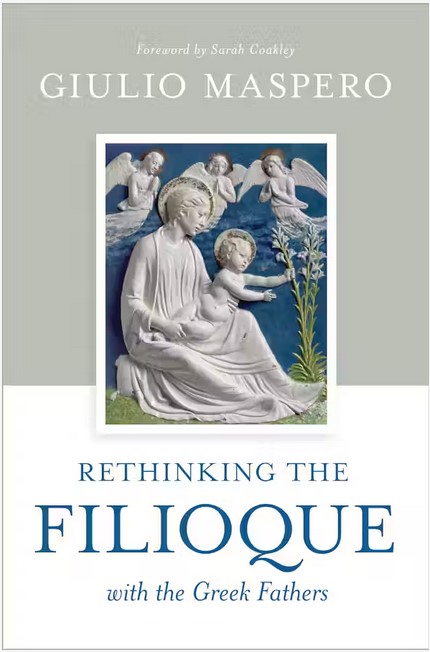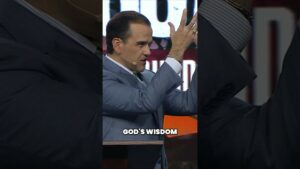Giulio Maspero: Rethinking the Filioque with the Greek Fathers
Giulio Maspero, Rethinking the Filioque with the Greek Fathers (Grand Rapids: Eerdmans, 2023). Giulio Maspero’s book Rethinking the Filioque with the Greek Fathers addresses the seemingly perennial theological debate that has divided Christendom for a thousand years through a close reading of the development of trinitarian doctrine in the early Church. For those unfamiliar with […]
 Giulio Maspero, Rethinking the Filioque with the Greek Fathers (Grand Rapids: Eerdmans, 2023).
Giulio Maspero, Rethinking the Filioque with the Greek Fathers (Grand Rapids: Eerdmans, 2023).
Giulio Maspero’s book Rethinking the Filioque with the Greek Fathers addresses the seemingly perennial theological debate that has divided Christendom for a thousand years through a close reading of the development of trinitarian doctrine in the early Church. For those unfamiliar with the filioque controversy, a brief overview will help set the stage for Maspero’s book. “Filioque” is a Latin phrase that means “and the Son.” It was first added to the third heading of the Niceno-Constantinoplitan Creed (“I believe in the Holy Spirit…who proceeds from the Father and the Son”) at the regional Council of Toledo held in 589 and later adopted by the Western Latin-speaking Church under the jurisdiction of the Roman pontiff. Greek-speaking Christians saw this as problematic both ecclesiastically and theologically. Ecclesiastically, they saw it as an illegitimate addition to the Creed without ecumenical consent. It would be like a single state in the US making a change to the US Constitution and declaring that all the other states had to accept the change whether they liked it or not. Theologically, Greek-speaking authors thought that the addition of the filioque compromised the unity of God, which was seen to be found in the Father as the sole cause of the Trinity, by adding a second cause within the Godhead. Two causes meant there were two Gods. Ultimately, this became one of the issues that led to the schism between East and West Christendom in 1054 that has never been healed.
Maspero’s book is not an attempt to address all the issues of the Filioque. The history is long and this ground has been covered by others, such as A. Edward Siecienski’s excellent historical survey The Filioque: History of a Doctrinal Controversy (Oxford University Press, 2010). Any reader interested in Maspero’s book should read Siecienski’s book first to familiarize themselves with the history. Instead, Maspero focuses on giving a nuanced historical reading of the development of filioque within the development of trinitarian doctrine in the early church from Origen (c 185-254) to Gregory of Nyssa (c. 335-395). At each stage, Maspero is careful to explain how these authors were addressing specific issues in their own time and how that affected their articulation of Trinitarian doctrine.
For example, Origen (the subject of chapter 1) was addressing both Stoic materialism and Gnostic cosmology when he made a sharp distinction between God and creation but kept an ordered hierarchy within the Trinity such that the Father was more truly God than the Son, and the Son more God than the Holy Spirit. This Logos-theology (as he calls it) resulted in two models of the Trinity: the linear model (Father → Logos → Pneuma) and the triangular model ( Logos ← Father → Pneuma). These were never resolved in Origen and led to the Arian controversy at the beginning of the fourth century. Maspero then traces (chapters 2 and 3) how these two models worked themselves out in the fourth century in authors like Epiphanius, Pseudo-Athanasius, Athanasius, Eusebius of Caesarea and Marcellus of Ancyra. While Athanasius’s nature (physis)-theology approach might have helped address the Arian debates over the status of the Son, it was insufficient to answer the so-called Pneumatomachians (=Spirit Fighters) who affirmed the divinity of the Son but denied the divinity of the Holy Spirit. It is this debate seen in authors like Gregory of Nazianzus and especially Gregory of Nyssa (chapters 4 and 5) that Maspero focuses on as the immediate context for the development of the Greek filioque.
I think this is a particularly important contribution not only to debates about the filioque but also to general discussions about the Trinitarian debates of the fourth century. Too often the Pneumatomachian controversy is an appendix to the Arian controversy. “Once the Arian controversy was solved,” so the story typically goes, “there were some weird people who denied the divinity of the Holy Spirit but that was an anomaly and everybody just moved on until the Christological controversies of the fifth century.” Instead, Maspero argues that the Pneumatomachian controversy highlighted a gap in the nature (physis) model that made the Pneumatomachian position a comprehensible position to hold. It is in their response to the Pneumatomachians that Gregory of Nazianzus and Gregory of Nyssa shifted from the question of nature to the question of relation that allowed them to sufficiently answer the Pneumatomachian objections: the identity of the Son and Spirit is distinguished by a difference in the way they relate to the Father (Son is begotten; Spirit proceeds). More so, the Spirit, argued the two Gregories, is metaphysically placed in between the Father and the Son such that the Father can remain cause while admitting an active role of the Son in the procession of the Holy Spirit.
Maspero then tests his hypothesis by comparing these Greek developments with the Syrian theological tradition (chapter 6). Here Maspero once again demonstrates historical nuance in attending to the linguistic difficulties in translating concepts developed in a Greek-speaking context into a Syrian one. Namely, Gregory of Nazianzus was able to distinguish procession as a general category (proion) from the specific relation of the Spirit to the Father (ekporeutōs). Not only does the Syrian Church’s adaptation of the Creed in 410 explicitly say that the Spirit proceeds from the Father and the Son—as well as being present in their own nascent theologians such as Ephrem the Syrian—but Syriac translations of the Cappadocians use filioque-type language to express Gregory’s terminological distinction that was unavailable to them in Syriac. When placed in the highly technical Trinitarian debates of the fourth century, it becomes clear that this evidence isn’t merely the result of translation, but of conceptual pressure arising from the Pneumatomachian debates at the end of the fourth century.
The rest of the book is a comparison between what Maspero has discovered in the Greek (and Syrian) Fathers, with the theological developments in the West, specifically Augustine. Augustine, as the most important Latin-speaking theologian, is usually charged with being the source of the filioque. In chapter 7, Maspero addresses the issue of the so-called “psychological analogy” of the Trinity which plays an important part in Augustine’s De Trinitate. Was this a cause of the filioque? Maspero argues that it was not because he also has discovered a similar, though not identical, psychological analogy at work in Gregory of Nazianzus, Gregory of Nyssa, and the seventh-century theologian Anastasius of Sinai (which he argues is independent of Augustine’s influence). Secondly, in chapter 8, Maspero takes a close look at the metaphysical differences between Augustine and the Cappadocians. While he thinks that Augustine is at a conceptual disadvantage compared to the Greek-speaking East—specifically on the ontological status of relation—Maspero shows how Augustine is driven by similar conceptual pressures (a shared theological grammar) as Gregory of Nyssa to affirm a role of the Son in the procession of the Spirit.
Maspero finally concludes with a summary of his argument and an ecumenical proposal: affirm a Greek understanding of the active (but not causal) role of the Son in the procession of the Holy Spirit.
Maspero has written a nuanced and highly technical, historical, and theological investigation of the “Greek Filioque”. While he gives helpful summaries of his argument along the way to mark the trail he is blazing, this is still an admittedly difficult book and requires a slow and careful reading. Those unfamiliar with scholarship on the Trinitarian debates of the fourth century would do well to read Lewis Ayres’s Nicaea and Its Legacy or Mark DelCogliano’s introduction and translation of Basil of Caesarea’s Against Eunomius. Nevertheless, this is an important and necessary book for three reasons. First, Maspero demonstrates how to do historical theology well. Historical theology isn’t just appealing to what theologians of the past have said, but why they said it. Second, I think Maspero does an excellent job of showing how biblical exegesis was an integral part of these debates. These early Christians weren’t just philosophizing or engaging in abstract conceptual arguments for their own sake. Their reflections arise out of their close reading of the Bible to address the needs of their time. While we might not always understand the nuances of their exegesis, we should walk away from Maspero’s book appreciating just how important the Bible was for them in these debates. Third, remembering the role the filioque played in the division of 1054, Maspero’s work is an important contribution to healing those rifts so that we, as Jesus prayed, might be one.
Reviewed by Ryan Clevenger
Publisher’s page: https://www.eerdmans.com/9781467466417/rethinking-the-filioque-with-the-greek-fathers/




